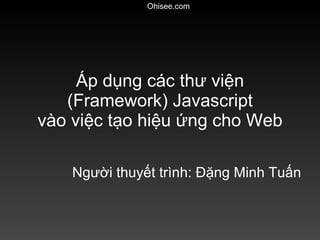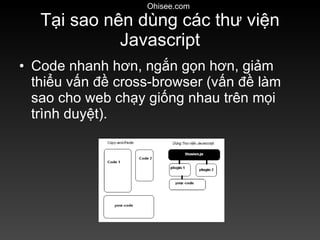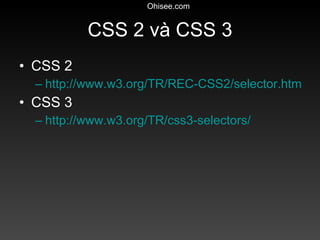Hoc Jquery Trong 1h
- 1. ├üp dß╗źng c├Īc thŲ░ viß╗ćn (Framework) Javascript v├Āo viß╗ćc tß║Īo hiß╗ću ß╗®ng cho Web NgŲ░ß╗Øi thuyß║┐t tr├¼nh: ─Éß║Ęng Minh Tuß║źn
- 2. ─É├┤i n├®t vß╗ü ngŲ░ß╗Øi thuyß║┐t tr├¼nh ─Éß║Ęc biß╗ćt y├¬u th├Łch c├Īc vß║źn ─æß╗ü li├¬n quan ─æß║┐n clientside (Web Standard, HTML, CSS, Javascript). ─É├Ż l├Ām mß╗Öt sß╗æ dß╗▒ ├Īn li├¬n quan ─æß║┐n tß╗æi Ų░u h├│a clientside code cho Microsoft (CSS Adapters) v├Ā NAISCORP (www.socbay.com)
- 3. Mß╗źc ─æ├Łch cß╗¦a buß╗Ģi Seminar ─ÉŲ░a ─æß║┐n kh├Īi niß╗ćm cŲĪ bß║Żn vß╗ü c├Īc thŲ░ viß╗ćn Javascript n├│i chung, v├Ā 1 thŲ░ viß╗ćn Javascript nß╗Ģi tiß║┐ng l├Ā Jquery, n├│i ri├¬ng. ├üp dß╗źng Jquery v├Āo viß╗ćc tß║Īo c├Īc hiß╗ću ß╗®ng sinh ─æß╗Öng cho Web.
- 4. Nß╗Öi dung ch├Łnh Giß╗øi thiß╗ću vß╗ü Web2.0, vai tr├▓ cß╗¦a Animation v├Ā AJAX trong Web2.0 Giß╗øi thiß╗ću c├Īc thŲ░ viß╗ćn Javascript nß╗Ģi tiß║┐ng nhŲ░ Jquery, YUI, Prototype Giß╗øi thiß╗ću vß╗ü CSS 2 v├Ā CSS 3 Demo mß╗Öt sß╗æ v├Ł dß╗ź ├Īp dß╗źng Jquery Giao lŲ░u, trß║Ż lß╗Øi c├óu hß╗Åi c├Īc vß║źn ─æß╗ü li├¬n quan
- 5. Web 2.0 Thuß║Łt ngß╗» Web 2.0 C├Īc v├Ł dß╗ź vß╗ü hiß╗ću ß╗®ng web http://www.noupe.com/jquery/50-amazing-jquery-examples-part1.html
- 6. Demo V├Ł dß╗ź vß╗ü 1 sß╗æ hiß╗ću ß╗®ng web d├╣ng Jquery Plugin http:// www.ericmmartin.com/simplemodal / http:// jquery.bassistance.de /validate/demo/ http:// interface.eyecon.ro/demos/drag_drop_tree.html http:// interface.eyecon.ro/demos/sort.html http:// gmarwaha.com /blog/?cat=8
- 7. C├óu hß╗Åi: Bß║Īn muß╗æn viß║┐t code JavaScript theo c├Īch n├Āo? T├¼m (trong s├Īch hoß║Ęc tr├¬n Internet) v├Ā copy-and-paste. Tß║Łp hß╗Żp nhß╗»ng ─æoß║Īn code Javascript thŲ░ß╗Øng d├╣ng v├Āo mß╗Öt nŲĪi, khi cß║¦n ─æoß║Īn n├Āo th├¼ lß║źy ─æoß║Īn ─æ├│ ra, v├Ā chß╗ēnh sß╗Ła bß╗Ģ sung. Muß╗æn l├Ām g├¼ th├¼ viß║┐t tß╗½ ─æß║¦u.
- 8. Thß║┐ n├Āo l├Ā Javascript Framework Javascript framework, hay thŲ░ viß╗ćn Javascript, hay Javascript Library, l├Ā kh├Īi niß╗ćm tŲ░ŲĪng tß╗▒ c├Īc thŲ░ viß╗ćn trong lß║Łp tr├¼nh C nhŲ░: stdlib, stdio. Kh├┤ng ai lß║Łp tr├¼nh C m├Ā kh├┤ng d├╣ng mß╗Öt thŲ░ viß╗ćn n├Āo cß║Ż. Trong C: #include< stdio.h > Trong Javascript: <script type="text/javascript" src=/slideshow/hoc-jquery-trong-1h-presentation/646915/"/js/lib/ lib.min.js "></script>
- 9. Tß║Īi sao n├¬n d├╣ng c├Īc thŲ░ viß╗ćn Javascript Code nhanh hŲĪn, ngß║»n gß╗Źn hŲĪn, giß║Żm thiß╗āu vß║źn ─æß╗ü cross-browser (vß║źn ─æß╗ü l├Ām sao cho web chß║Īy giß╗æng nhau tr├¬n mß╗Źi tr├¼nh duyß╗ćt).
- 10. Khi n├Āo th├¼ KH├öNG n├¬n d├╣ng c├Īc thŲ░ viß╗ćn Javascript c├│ sß║Ąn Khi ─æang hß╗Źc vß╗ü Javascript Kh├┤ng ŌĆ£giß║┐t g├Ā bß║▒ng dao mß╗Ģ tr├óuŌĆØ. Khi tß╗▒ x├óy dß╗▒ng c├Īc thŲ░ viß╗ćn Javascript cho ri├¬ng m├¼nh.
- 11. C├│ nhß╗»ng loß║Īi thŲ░ viß╗ćn Javascript n├Āo?
- 12. Thß║┐ n├Āo l├Ā mß╗Öt thŲ░ viß╗ćn Javascript tß╗æt? Hß╗Ś trß╗Ż trong viß╗ćc giß║Żi quyß║┐t c├Īc vß║źn ─æß╗ü thŲ░ß╗Øng gß║Ęp (sß╗Ł l├Į DOM, AJAXŌĆ”) Cross-browser C├│ t├Āi liß╗ću hŲ░ß╗øng dß║½n sß╗Ł dß╗źng chi tiß║┐t. Dß╗ģ d├╣ng ├Źt xung khß║»c vß╗øi c├Īc thŲ░ viß╗ćn Javascript kh├Īc.
- 13. C├Īc thŲ░ viß╗ćn m├Ż nguß╗ōn mß╗¤
- 14. ╠²
- 15. Giß╗øi thiß╗ću c├Īc thŲ░ viß╗ćn nß╗Ģi tiß║┐ng
- 16. Tß╗Ģng quan vß╗ü Prototype Bß║»t ─æß║¦u tß╗½ ─æß║¦u 2005 bß╗¤i Sam Stephenson Nhanh ch├│ng ph├Īt triß╗ān, gß║»n liß╗ün vß╗øi cß╗Öng ─æß╗ōng Ruby on Rails ─ÉŲ░ß╗Żc hß╗Ś trß╗Ż bß╗¤i c├┤ng ty 37 Signals
- 17. Tß╗Ģng quan vß╗ü Jquery ─ÉŲ░a ra v├Āo th├Īng 1 n─ām 2006 bß╗¤i John Resig (─æang l├Ām Team Leader tß║Īi c├┤ng ty Mozilla ŌĆō c├┤ng ty l├Ām ra Firefox) Ph├Īt triß╗ān rß║źt nhanh. Rß║źt nhiß╗üu lß║Łp tr├¼nh vi├¬n khß║»p thß║┐ giß╗øi tham gia ph├Īt triß╗ān v├Ā viß║┐t Plugin cho n├│.
- 18. Tß╗Ģng quan vß╗ü YUI Ra mß║»t th├Īng 2 n─ām 2006 bß╗¤i Yahoo! Ph├Īt triß╗ān v├Ā hß╗Ś trß╗Ż trong nß╗Öi bß╗Ö c├┤ng ty Yahoo. Mß╗źc ─æ├Łch chuß║®n h├│a vß╗ü JavaScript cho nß╗Öi bß╗Ö c├┤ng ty, nhŲ░ng cho ph├®p mß╗Źi ngŲ░ß╗Øi ─æß╗üu ─æŲ░ß╗Żc sß╗Ł dß╗źng.
- 19. Tß╗Ģng quan vß╗ü Dojo Ph├Īt triß╗ān v├Āo ─æß║¦u n─ām 2005 bß╗¤i Alex Russell + Co. Cß╗Öng ─æß╗ōng ph├Īt triß╗ān lß╗øn. Nhiß╗üu c├┤ng ty lß╗øn hß╗Ś trß╗Ż (IBM, AOL) ThŲ░ viß╗ćn rß║źt lß╗øn, hß╗Ś trß╗Ż rß║źt nhiß╗üu chß╗®c n─āng.
- 20. Tß║Īi sao chß╗Źn JQuery Dß╗ģ d├╣ng, code ngß║»n gß╗Źn, dß╗ģ hiß╗āu File thŲ░ viß╗ćn nhß╗Å gß╗Źn C├│ nhiß╗üu Plugin Nhiß╗üu c├┤ng ty lß╗øn d├╣ng n├│: Google, BBC, Digg, Wordpress, Amazon, IBM. Mß╗Öt sß╗æ c├┤ng ty Web Viß╗ćt Nam d├╣ng Jquery: NAISCORP(socbay), VCCORP(baamboo), VINAGAME(zing)ŌĆ” Note: Right Tool for Right Job
- 21. So s├Īnh Jquery vß╗øi c├Īc thŲ░ viß╗ćn kh├Īc Kh├Īc vß╗øi Prototype v├Ā mooTools... ... N├│ kh├┤ng ph├Ī hoß║Īi global namespace cß╗¦a bß║Īn. Kh├Īc vß╗øi YUI... ... N├│ rß║źt ngß║»n gß╗Źn, c├┤ ─æß╗Źng YUI: YAHOO.util.Dom.getElementsByClassName() Jquery: $() Kh├Īc vß╗øi Dojo... ... Bß║Īn c├│ thß╗ā hß╗Źc n├│ trong Nß╗Ła Tiß║┐ng (vß╗øi ─æiß╗üu kiß╗ćn bß║Īn ─æ├Ż nß║»m vß╗»ng CSS)!
- 22. T├│m tß║»t lß║Īi kiß║┐n thß╗®c vß╗ü CSS ─Éß╗ā hß╗Źc Jquery, bß║Īn buß╗Öc phß║Żi nß║»m vß╗»ng CSS #nav => mß╗Źi element c├│ id=ŌĆ£navŌĆØ div#intro h2 => mß╗Źi element h2 nß║▒m trong div c├│ id=ŌĆ£introŌĆØ #nav li.current a => mß╗Źi element a nß║▒m trong element li vß╗øi class=ŌĆ£currentŌĆØ nß║▒m trong phß║¦n tß╗Ł bß║źt kß╗│ c├│ id=ŌĆ£navŌĆØ
- 23. CSS 2 v├Ā CSS 3 CSS 2 http://www.w3.org/TR/REC-CSS2/selector.html CSS 3 http://www.w3.org/TR/css3-selectors/
- 24. Jquery v├Ā h├Ām $() $().ready ( function() { ŌĆ”ŌĆ”ŌĆ”ŌĆ”ŌĆ”ŌĆ”ŌĆ”ŌĆ”ŌĆ”ŌĆ”ŌĆ” . } ) ; So s├Īnh vß╗øi window.onload = function() { ŌĆ”ŌĆ” . } ;
- 25. 3 mß╗®c ─æß╗Ö sß╗Ł dß╗źng Jquery Cß║źp 1: d├╣ng trß╗▒c tiß║┐p Jquery hoß║Ęc Plugin cß╗¦a n├│ m├Ā kh├┤ng cß║¦n hiß╗āu bß║Żn chß║źt. Cß║źp 2: hiß╗āu bß║Żn chß║źt cß╗¦a Jquery v├Ā Plugin cß╗¦a n├│ ─æß╗ā c├│ thß╗ā tß╗▒ viß║┐t ra Plugin cß╗¦a ri├¬ng m├¼nh hoß║Ęc chß╗ēnh sß╗Ła m├Ż nguß╗ōn Jquery. Cß║źp 3: tham khß║Żo Jquery ─æß╗ā tß╗▒ viß║┐t ra thŲ░ viß╗ćn yourname.js nß╗Ģi tiß║┐ng thß║┐ giß╗øi nhŲ░ Jquery.
- 26. Demo vß╗ü Jquery, so s├Īnh n├│ vß╗øi c├Īch l├Ām b├¼nh thŲ░ß╗Øng (raw code) B├Āi to├Īn 1: Tß║Īo ra bß║Żng kiß╗āu ngß╗▒a vß║▒n (zebra)
- 27. DEMO C├Īch 1: D├╣ng HTML + CSS C├Īch 2: D├╣ng Javascript theo c├Īch b├¼nh thŲ░ß╗Øng C├Īch 3: D├╣ng Jquery Tham khß║Żo: http://www.langtags.com/jses/articles/20061119/a218618280.html
- 28. Demo vß╗ü Jquery, so s├Īnh n├│ vß╗øi c├Īch l├Ām b├¼nh thŲ░ß╗Øng (raw code) B├Āi to├Īn 2: Validate email trong form
- 29. DEMO C├Īch 1: D├╣ng Javascript theo c├Īch b├¼nh thŲ░ß╗Øng C├Īch 2: D├╣ng Jquery Tham khß║Żo: http://jquery.bassistance.de/validate/demo/
- 30. Khi l├Ām AJAX c├│ thß╗ā ├Īp dß╗źng Jquery kh├┤ng? C├│ thß╗ā ├Īp dß╗źng Jquery! V├Ł dß╗ź (kh├┤ng DEMO) D├╣ng AJAX theo c├Īch b├¼nh thŲ░ß╗Øng http://www.w3schools.com/Ajax/ajax_server.asp D├╣ng AJAX ├Īp dß╗źng Jquery http://docs.jquery.com/AJAX $("#feeds").load("feeds.html");
- 31. Giao lŲ░u Hß╗Åi ─æ├Īp vß╗ü CSS, Jquery, thß╗▒c tß║┐ ├Īp dß╗źng CSS v├Ā Jquery tß║Īi c├Īc c├┤ng ty phß║¦n mß╗üm ß╗¤ Viß╗ćt Nam: http://ohisee.com/?p=906



















































































![[Cntt] b├Āi giß║Żng lß║Łp tr├¼nh c trong windows](https://cdn.slidesharecdn.com/ss_thumbnails/cnttbiginglptrnhctrongwindows-160829131336-thumbnail.jpg?width=560&fit=bounds)






















